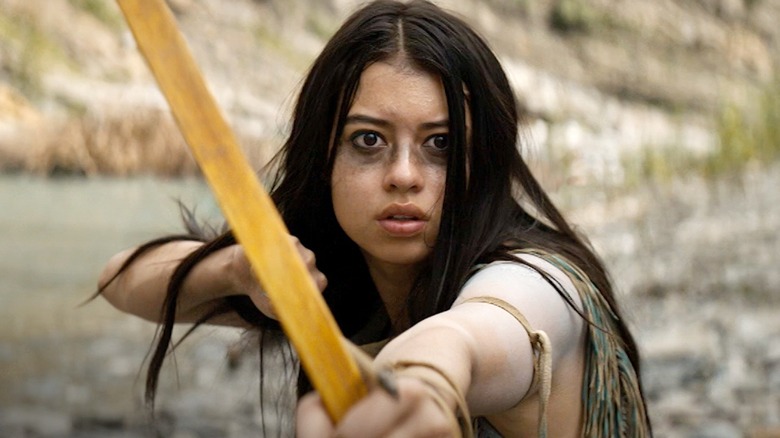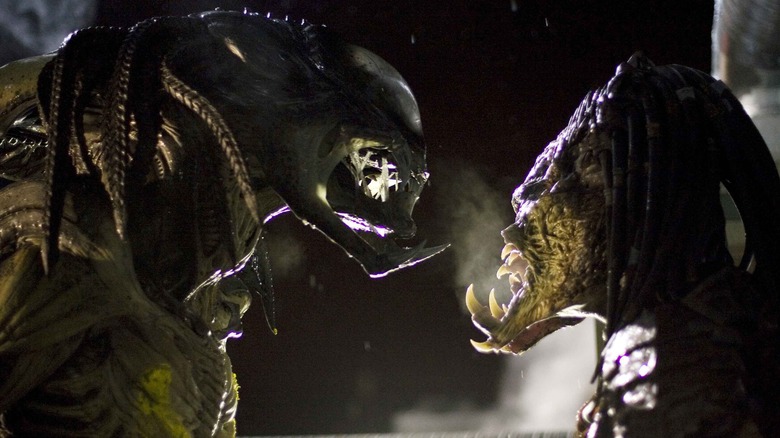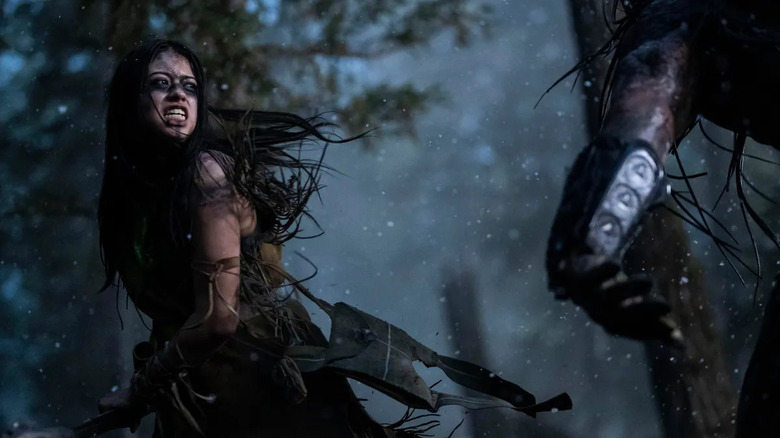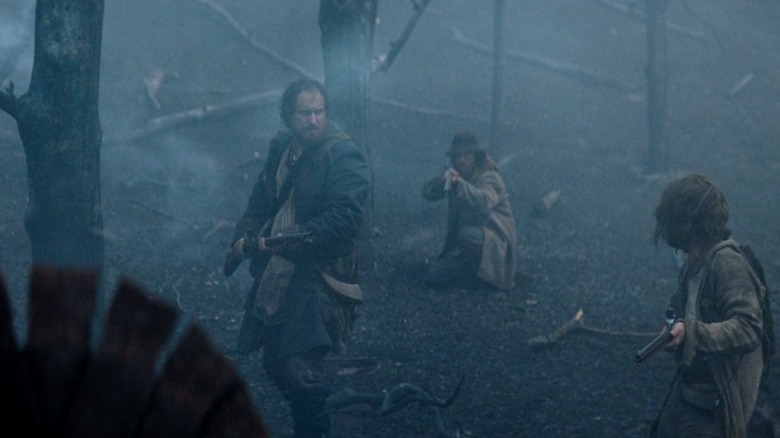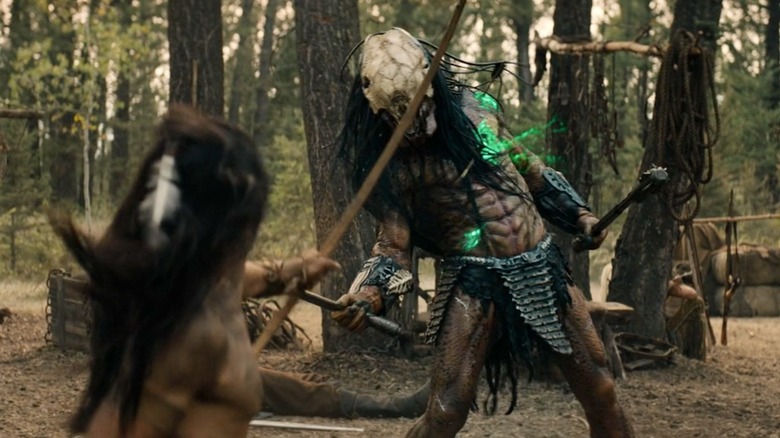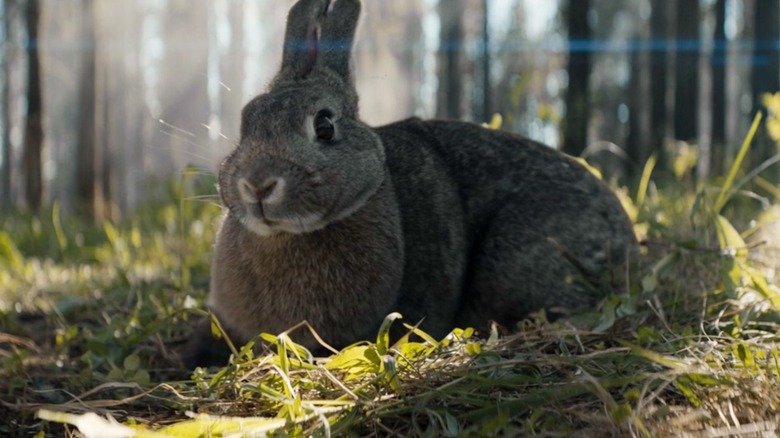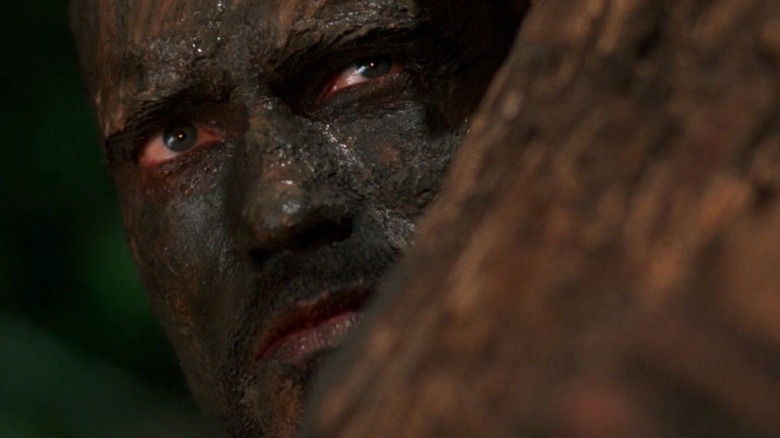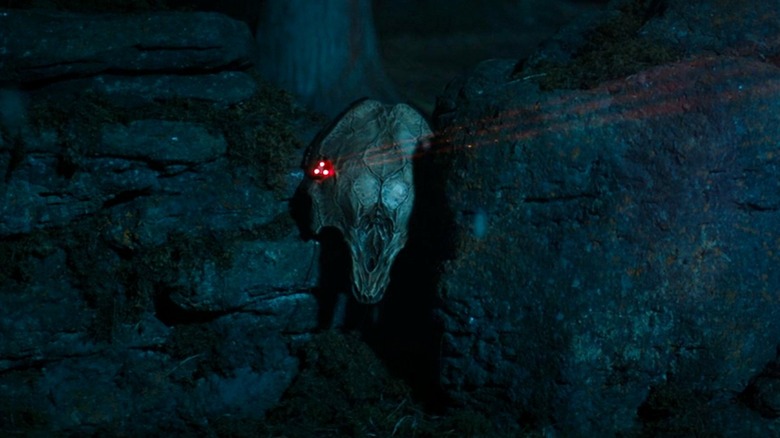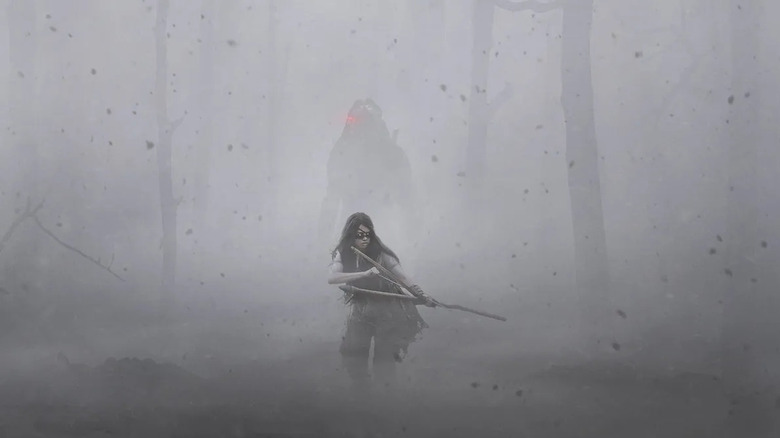Prey Reminds Us That Predator Was Never About Firepower
Warning: Spoilers ahead for "Prey."
It isn't easy for the fifth movie in a franchise (seventh, if you count the "Alien vs. Predator" movies) to feel original and refreshing while also remaining true to the core of the franchise — but Dan Trachtenberg's "Prey" manages it.
Part of that is owed to its place in the woefully under-explored genre of historical sci-fi. Aside from new adaptations of old science fiction stories like "Frankenstein," "John Carter of Mars," and "The Time Machine," Hollywood seems to assume by default that if a movie contains sci-fi concepts, it must be set in either the present day or the future. Even classics like "War of the Worlds" and "I Am Legend" got a modern makeover when adapted for the big screen in 2005 and 2007, respectively.
The inevitable internet backlash to casting a female protagonist in a historically male-led action franchise isn't really worth responding to. But what is interesting is how that backlash seems to have exposed some collective retconning of the plot of "Predator," with many people apparently remembering it as a movie where the Predator is defeated using muscles, testosterone, and big guns.
In fact, what "Prey" does particularly well is to remind audiences just how useless raw strength and firepower proved to be for Dutch (Arnold Schwarzenegger) and the original lineup of mostly-doomed Vietnam War vets — and how Dutch ultimately survived by being the smartest member of the group, not the strongest.
Who would win in a fight?
"Who would win in a fight between..." has been a fun thought experiment (and sometimes a vitriolic debate) among genre fans for decades — not to mention being the question that fueled the "Alien vs. Predator" movies. More recently we've seen a trend of big "versus" franchise movies: "Batman V Superman: Dawn of Justice," "Captain America: Civil War," "Godzilla vs. Kong," and, of course, "Ford V Ferrari."
The "Predator" movies are no stranger to the trope of mortal combat; in fact, it's a core part of their mythology. Within the horror genre, they're a counterpart to slasher movies like "Halloween" and "The Texas Chain Saw Massacre," which spend most of their runtime killing off supporting characters until only the final girl remains. But whereas slasher movies often leave the killer alive (merely escaping with her life is enough of a victory for the final girl), the action DNA of the "Predator" movies demands a climactic one-on-one showdown. Bulging muscles and big guns were a defining part of the original movie's imagery, and the Predator's raison d'être is the search for a "worthy" opponent.
So, how do you make a "Predator" movie where the protagonist is a teenage girl, set in an era where guns fire one bullet and then take forever to reload?
It's a Predator's world
Hollywood has had a long struggle with the concept of the "strong female character," and that's especially true in the action genre, where "strong" is usually thought of in very literal terms. The most popular female characters tend to be masculine-coded in order to fit in, with sleeveless costumes to show off their toned arms, and big guns to back them up. When female leads are coded in more feminine ways (think "Dark Angel" or "Black Widow"), their physical strength is often beefed up in the script with cybernetics, superpowers, genetic experimentation, or a backstory of being trained as a killing machine from childhood. The go-to tactic for explaining away any outward mismatch in brawn is "she's stronger than she looks!"
"Prey" falls into some of these patterns; Naru's (Amber Midthunder) fighting prowess is explained by her secretly training in the woods, and there is one fight sequence in which she takes on several human opponents and defeats them single-handedly — though Naru's bladed weapons and the element of surprise help to even the playing field there. But the movie doesn't shy away from the fact that Naru is physically at a disadvantage to the young men she seeks to hunt alongside, let alone the Predator itself. And it doesn't treat her gender like a taboo topic to be politely ignored, either.
Instead, Patrick Aison's script engages with the fact that Naru is rebelling against the tribe's traditional gender roles (one moment pointedly shows her walking in the opposite direction to the rest of the women). She's determined to be a hunter, to complete a rite of passage known as kühtaamia, in which she must successfully hunt an animal that can hunt her back.
In that sense, she and the Predator have the same goal: to find a worthy opponent and conquer it.
Firepower is overrated
Naru might be the only character to fight the Predator and come out alive, but even before that, "Prey" makes a clear distinction between the fighting styles of the Comanche warriors and the French trappers. Though the trappers have more modern firepower, it proves to be more of a weakness than a strength due to their trained over-reliance on guns. In one memorable moment, three of the men fire off shots at the Predator and then stare at it helplessly for a moment before slowly trying to reload. (Needless to say, they don't get to finish.)
There's more to the trappers' tactics than just comic relief, however. This faction does have some success when they deploy ambush tactics: using their bleeding captives as bait, leaving a steel trap for the Predator to walk into, and then bursting out of the ground to restrain it with a net as it reels from its wound. The plan only fails when one of the trappers becomes too arrogant and underestimates his opponent. (There's another lesson to be learned here.)
The Comanche, by contrast, fare a lot better. After Wasape (Stormee Kipp) is killed, Ania (Cody Big Tobacco) and Huupi (Tymon Carter) don't panic or immediately rush in, but hang back behind cover and watch for the attacker. When the Predator reveals itself by pulling its bolts out of Wasape, they first attack with arrows, disrupting its cloaking. Then they fight strategically, deploying screams as a distraction and slashing at the Predator from opposite sides. Huupi survives for a few beats by dodging attacks, and Ania manages to get in one last hit on the Predator by returning to attack it from behind. They're both brutally slaughtered, of course, but even lasting a minute in direct combat with a Predator is impressive.
Taabe vs. the Predator
Comanche tactics are taken to another level in Taabe's (Dakota Beavers) fight with the Predator. Sarii initially runs in barking, providing enough of a distraction for Taabe to hit the Predator from behind and knock off its mask. Taabe then smartly maintains his distance, whooping to distract the Predator and dodging as it fires bolts from its wrist cannon at him.
(This is a good opportunity to debunk claims that the Predator "forgets how its weapons work" in the final battle of "Prey." The fight with Taabe demonstrates that the bolts can be fired without the aid of the mask's laser sights, and that momentum initially carries them in a straight line before they curve around to wherever the laser sights are aiming. Each time the Predator fires at Taabe, he has to dodge on horseback to avoid being hit. While the auto-aim is certainly an advantage for the Predator, this fight scene makes it clear that manual aim can be just as effective over short distances, and the Predator won't hesitate to shoot just because its mask is missing, a detail that Naru is shown closely observing.)
Modern firepower fails again in this fight, as Naru loads the pistol only to have it fail when she attempts to shoot. Instead, she deploys the same tactic that Ania, Huupi, and Taabe used: yelling at the Predator to distract it, which in turn gives Taabe an opening to brutally wound the creature with its own spear. After that, Taabe dominates the fight by maintaining his distance and wounding the Predator with arrows ... until, of course, it cheats by turning invisible. Even then, Taabe uses his last moments alive in the fight to injure the Predator further, weakening it ahead of Naru's fight so that she can "bring it home."
The power of prey
In "Prey," Naru is shown failing over and over again. While hunting a mountain lion, she gets knocked out and has to be carried back to the settlement. While trying to hunt a bear, she is forced to escape by hiding in a beaver dam and only survives because the Predator comes along and kills the bear. She's disarmed and overpowered by her brother's friends when they seek to take her back to the camp, and soon after that, she's kidnapped by the French trappers. The majority of the fights that Naru engages in end with her running away. But then, running away was also the approach that helped Dutch survive the Predator.
In a scene early on in "Prey," the Predator observes a wolf hunting a rabbit, assesses the role of the two animals, and chooses to fight the wolf while letting the rabbit run free. The moment is echoed later in the movie when Naru and Itsee (Harlan Kytwayhat) are running from the Predator. Itsee is killed, but when Naru gets caught in a trap and left helpless, the Predator observes her for a moment and then lets her live. From this, Naru deduces something crucial about her opponent: it has identified her as a prey creature, and therefore of no interest.
While big guns and bulging muscles were a major part of the marketing for "Predator," Dutch also observed that the best way to escape the Predator is to go without a weapon and appear harmless, since an unarmed opponent offers no sport. When Anna (Elpidia Carrillo) attempts to grab a gun to fight back against the creature, Dutch is quick to disarm her in order to save her life.
The Predator itself is, first and foremost, a hunter, and it can only be defeated by thinking like a hunter.
Patience is a virtue
Both Dutch and Naru eventually realize that the Predator's deadliest weapon isn't a wristblade or laser-targeted weapon, but the cloaking technology that makes it invisible to its prey until it's too late. This offers the crucial advantage of timing, allowing the Predator to wait for the best possible moment before launching its attack. This deadly strength is balanced out by a crucial weak spot: the Predator's thermal vision, which allows an opponent to become invisible to it simply by concealing their heat signature with cool mud (like Dutch does) or chewing herbs that cool the blood (like Naru does).
Naru's winning strategy against the Predator is foreshadowed twice in "Prey." When she is watching a bird overhead with her bow drawn, Taabe grows impatient and shoots it down first, teasing Naru for "sleeping." She tells him that she was waiting for the bird to circle back around, and points out that he now has to cross the river to collect its body. Later, Paaka (Corvin Mack) scorns Naru's plan to hunt the mountain lion by hiding in a tree and baiting it, telling her: "A hunter doesn't wait. He hunts."
Taabe later admits to Naru that while she may have been knocked out before the lion was killed, he was able to kill it thanks to her plan. And waiting, more than anything else is the key to Naru's eventual victory over the Predator. If she had joined in the initial fight between the creature and the other Comanche fighters, she would never have had time to learn that it has no interest in "prey" animals. She would never have learned that cooling a person's body down renders them invisible to it. She wouldn't have been able to observe the Predator jumping through trees and realized that it was vulnerable to tree traps.
In short, waiting for the right moment to strike is what equips Naru with the knowledge she needs to actually kill it.
Ready, aim, fire
"Prey" feels reminiscent of a video game, with the Predator as the final boss fight. It's established early on that trying to confront the alien hunter face-to-face is, as Dutch put it, a "bad idea." Even with the species' technology de-evolved by 300 years, and even with hints that this Predator is fairly young and inexperienced, it still has far too many advantages for even the strongest Comanche fighters to be able to defeat it.
And so, like the player character in a video game, Naru survives her early encounters by running away and gradually builds up her arsenal of weapons; the tomahawk gets a rope upgrade and she acquires a certain pistol belonging to one of the trappers. While she is growing stronger, the Predator is growing weaker; with each battle that Naru observes but doesn't engage in, it picks up a few more wounds and loses more blood.
In true final boss battle style, her eventual fight with the Predator happens in stages. Naru still can't survive head-on combat with the creature, so instead, she first weakens it with two surprise attacks, then manages to get it to cut off one of its own arms before opening up other wounds on its body. None of this is even in a real attempt to win a war of attrition (a fight that Naru would still inevitably lose), but instead is a means of angering the Predator enough to draw it into the trap that was laid earlier.
Naru's careful staging of the battle arena, from her opening blow to the final trick, is effectively a recap of everything the movie has taught us about how to hunt a Predator.
The art of the hunt
One final advantage of "Prey" being set in the past and featuring a Predator exploring Earth for the first time is the way in which it ties the Predator's hunting tactics back to the animal kingdom. Initially, the Predator is seen working its way up Earth's food chain by fighting every sentient creature that it observes to be a hunter of other animals. Before it gets around to humans, its first opponents are a snake, a wolf, and then a bear.
Though humans and the Predator might be more intelligent than most animals, the principles of hunting are largely the same: strategy matters far more than size. Animals might go head-to-head in displays of strength when fighting for mating rights or territory, but those battles are more for show and often allow both fighters to walk away with only superficial wounds. When it comes to hunting down prey, a stoat can kill a rabbit many times its own size by first chasing it to exhaustion, then delivering a strategic bite to the back of the neck. Lions take down animals much larger than themselves by hunting in packs. Crocodiles use camouflage and patience, waiting for their prey to get close enough. Other ambush hunters, like spiders, set a trap and wait for something to walk into it. A lot of the techniques that humans still use in combat today can be traced back to the animal kingdom.
Just as Dutch fought the original Predator and lived by discarding his gun, covering himself in mud, and getting very old school with his weapons, "Prey" brings the franchise back to its roots by getting back to the fundamentals of hunting: patience, planning, and spotting your prey before its spots you.
Also, it helps to have a dog.
